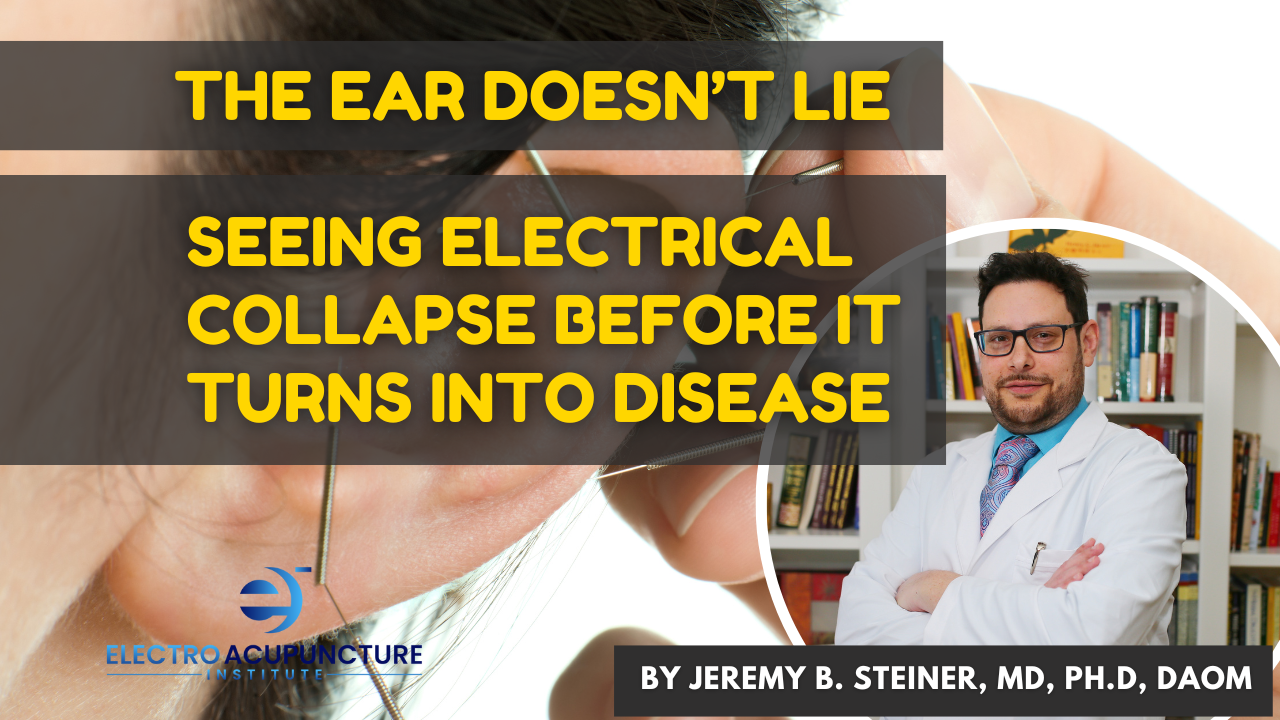Most practitioners think of the ear as an add-on—something you use for relaxation, smoking cessation, or stress relief. But what if the ear was actually the body’s most complete diagnostic system?
Sounds unlikely, right? Let’s look closer.
Every point on the auricle is wired to a channel, nerve, organ, or tissue in the body. When voltage begins to fall the first signs of terrain breakdown appear right there, on the surface of the ear.
Watch the Training: How to See Electrical Collapse Before It Turns Into Disease
Before we dive in, watch this short video training where Dr. Jeremy explains how voltage loss shows up in auricular zones, how to recognize the early signs of terrain failure, and what it means for your diagnosis and treatment strategy.
Watch the video below—and don’t forget to grab your free auricular diagnosis resource at the end of this training.
All Disease Starts in the Terrain
Before disease is ever named, before pain becomes chronic, before bloodwork changes—terrain failure begins. When a patient’s voltage drops below -20mV, the body’s ability to regenerate shuts down. Tissues weaken. Channels lose conductivity. And symptoms start to appear that seem unrelated but all share the same root cause: low voltage.
As acupuncturists, we’re trained to see patterns, but electro acupuncture lets us measure them. It allows us to see, in real time, how the body’s energy and physiology are working—or failing—to sustain health.
This is why we don’t chase symptoms. We follow voltage.
The terrain always tells the truth. And the best place to read that truth is the ear.
The Ear as a Voltage Map
The ear is the complete window into the body. Every channel, organ, and tissue has a representation there. These zones aren’t theoretical—they’re testable, measurable, and consistent. When voltage drops in an organ, nerve, or channel, you’ll see it immediately in its corresponding ear zone.
There are three main ways terrain collapse shows up on the ear:
- Electrical Deficiency – Using devices like Pointoselect, you’ll find zones that test as electrically deficient. These are the first signs of early collapse—before pain or dysfunction appear.
- Visual Markers – Broken vessels, discoloration, or changes in skin tone appear as the body attempts to shunt blood or energy toward areas that have lost electrical charge.
- Palpation or Pressure Changes – A simple press of a probe reveals tone changes or tenderness in the exact zone of low voltage. Decreased voltage creates ashi points.
The more you learn to read these signs, the less you’ll ever have to guess what’s wrong.
Acute vs. Chronic Terrain Failure
Electrical collapse follows a timeline. In acute conditions—like sprains, infections, or emotional trauma—you’ll find sharp, localized reflexes that light up immediately when scanned. These active reflexes test positive on a Pointoselect or similar diagnostic device and often calm down within 1–5 treatments once voltage is restored.
But chronic disease tells a different story. Over time, the body adapts to low voltage by remodeling tissue. That’s when you’ll begin to see visible changes—vessels thickening, pigment shifts, and structural distortions.
- Blemishes or dry, scaling skin mark long-term stagnation.
- Broken capillaries appear in zones tied to stressed organs.
- Flattened or swollen areas reveal voltage overload or depletion.
Chronic disease is voltage loss made visible.
When you see it on the ear, you’re looking at the story of how long the terrain has been in decline—and where it began.
How to Test Electrical Collapse Using the Ear
How to Diagnose and Treat Using the Four-Zone System
To simplify treatment and remove guesswork, every patient session begins with diagnosing four primary problems—one in each major electrical domain of the body. This approach limits your treatment to four points or zones while still achieving optimal clinical outcomes.
Here’s how to do it step-by-step:
Step 1: Start With the Patient’s Story
Ask targeted questions to identify their four main complaints or patterns. Most symptoms will point you toward one of the four core diagnostic zones: acupuncture channels, spinal nerves, tissues, or receptor points. The key is to listen for the terrain breakdown behind the symptom—not just the description of pain or dysfunction.
Step 2: Identify the Four Zones on the Ear
Once you understand the main issues, locate the four corresponding auricular regions:
- One in the Acupuncture Channels – where voltage deficiency in a meridian is creating systemic imbalance.
- One in the Spinal Nerves – where segmental collapse is affecting the organ or structure.
- One in the Tissues – reflecting local degeneration or inflammation.
- One in the Receptor Points – representing the brain-body interface, often tied to perception, pain, or emotion.
These four zones give you a complete diagnostic map of the terrain.
Step 3: Choose Your Entry Point
If the problem appears acute, use your Pointoselect or other scanning device to test for electrical deficiency. If the reading is below 8, that point is active and needs treatment.
If the problem appears chronic, begin with a visual inspection—look for blemishes, vessel changes, discoloration, or tissue thickening. These visible cues will guide you to the exact zones to test and treat.
Step 4: Confirm and Correlate
Cross-check what you see on the ear with what the patient reports. The goal is not to match symptoms but to identify where the terrain has collapsed. Each active or visibly disturbed point represents one of the four domains that needs to be treated.
Step 5: Treat the Four Zones
Once you’ve identified one point or area in each zone, treat them using electro acupuncture or auricular stimulation. Four points are all you need—one representing each system. Treat until the point’s resistance normalizes or the patient reports a perceptible shift.
Step 6: Trust the Process
This method isn’t rigid—it’s a framework to get you started. The more you practice, the more naturally you’ll see patterns emerge. You’ll begin to recognize how channel deficiencies, nerve imbalances, tissue degeneration, and receptor dysfunction weave together in each patient.
By focusing on just four zones, you simplify your workflow, conserve your energy, and deliver more precise results—without sacrificing depth or outcomes.
This system gives you a real-time diagnostic readout of the patient’s terrain-based acupuncture deficiencies and a clear strategy for where to begin treatment.
Why the Ear Is the Best Place to Start
The body is complex. The ear simplifies it.
When you start treatment from the ear, you can:
- Test points before needling
- Confirm diagnosis in seconds
- Track progress objectively, session by session
Even if a patient can’t articulate their symptoms clearly, auricular acupuncture gives you data. Voltage doesn’t lie. And with a scanning device, your treatment plan becomes measurable, reproducible, and clear.
What Happens When You Treat Based on Voltage, Not Guesswork
When you diagnose and treat from electrical collapse, your results become consistent. Patients feel changes faster. Chronic pain patterns begin to unwind. Emotional charge drops.
By using voltage as your guide, you move from “hoping” a point works to knowing it will.
This is the clinical heart of modern electro acupuncture—not stimulation, but regeneration. Terrain restoration begins when voltage is restored.
Download the Free Auricular Diagnostic and Treatment Guide
Want a visual breakdown of what to look for, which zones reflect which systems, and how to map voltage collapse in real time?
Inside, you’ll find:
- A full walkthrough of terrain collapse markers
- Device setup tips for scanning
- The scanning order we use clinically for efficient, accurate diagnosis
Start using this guide in your clinic and see how fast your clarity improves.
Take the Next Step
If this training helped you see the ear—and the terrain—in a new way, don’t stop here.
Watch the video, download your Auricular Diagnostic and Treatment Guide, and start applying these diagnostic steps to identify voltage collapse and terrain imbalance in your own patients. You’ll see how quickly confidence replaces guesswork once you begin using the ear as your diagnostic map.
Download the resource now:
Watch it on YouTube: https://youtu.be/66icDDKN8bwhttps://youtu.be/example
Stay curious, keep testing, and keep exploring the bridge between the body’s electrical and biological systems—because understanding that connection is where real healing begins.
Jeremy Steiner, MD, PhD, DAOM
Head Educator at The Electro Acupuncture Institute
For more great trainings go here: https://electroacupunctureinstitute.com/blog/





